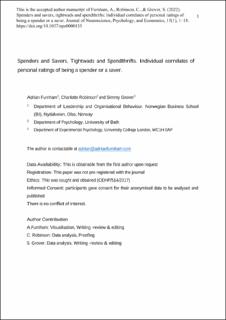| dc.description.abstract | There is limited literature on the causes, correlates, and consequences of being a saver (tightwad) or a spender (spendthrift). This paper reports on five studies which look at demographic, bright- and dark-side personality, money belief, and self-evaluation correlates of to what extent a person considers themselves a spender or saver. In each study, adult participants indicated their spender–saver habits on a single scale and completed a number of tests. The first study looked at trait correlates and showed savers were close-minded, conscientious, stable, extraverts. It also showed as predicted that savers were more likely to associate money with security, and not love or freedom, and claim to have better financial knowledge. The results from the second study on dark-side personality correlates indicated that spenders were more likely to have psychopathic tendencies, but less likely to be Machiavellian. The third study on personality disorder correlates of spender–saver tendencies suggested that spenders were likely to have elevated Cluster B personality disorders. The fourth study examined self-beliefs and showed savers rated themselves as more attractive, healthy, and intelligent than spenders. The fifth study, also using various self-ratings, showed spenders had more liberal political views, report higher emotional intelligence and are less likely to own their own home, while savers rated their physical health higher, and saw themselves as more entrepreneurial. Overall, the results suggest the simple saver–spender question is logically correlated with a number of individual difference variables with savers having a more positive profile. Implications and limitations are considered. | en_US |
